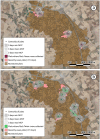Diet and Spatial Ecology Influence Red-Legged Partridge Exposure to Pesticides Used as Seed Treatment
- PMID: 37747849
- PMCID: PMC10569034
- DOI: 10.1021/acs.est.3c03905
Diet and Spatial Ecology Influence Red-Legged Partridge Exposure to Pesticides Used as Seed Treatment
Abstract
Seed treatment with pesticides is an extended agricultural practice with a high risk to granivorous birds that consume those seeds. To characterize that risk, it is necessary to understand the ecological factors that determine the exposure chances of birds to treated seeds. We investigated how pesticide uptake by red-legged partridges was related to cultivated plant ingestion and to the use of recently sown fields. We analyzed pesticide residues in 144 fecal samples from 32 flocks and determined the plant diet composition using DNA metabarcoding. Habitat use was studied through the monitoring of 15 GPS-tagged partridges. We confirmed, through the analysis of seeds, that >80% of cereal fields from the area had seeds treated with triazole fungicides. Tebuconazole was detected in 16.6% of partridges' feces. During the sowing season, cultivated plants accounted for half of the plant diet, but no association was found between cultivated plant consumption and pesticide intake. GPS tracking revealed that tebuconazole was detected in feces when partridges had recently used sown fields, whereas nonexposed partridges showed no overlap with recently sown areas. Our results highlight the need to incorporate field ecology into the characterization of pesticide exposure to improve the efficacy of environmental risk assessment.
Keywords: diet; farmland birds; pesticide exposure; spatial ecology; treated seeds.
Conflict of interest statement
The authors declare no competing financial interest.
Figures



Similar articles
-
Bird exposure to fungicides through the consumption of treated seeds: A study of wild red-legged partridges in central Spain.Environ Pollut. 2022 Jan 1;292(Pt A):118335. doi: 10.1016/j.envpol.2021.118335. Epub 2021 Oct 9. Environ Pollut. 2022. PMID: 34637835
-
A non-invasive method to monitor farmland bird exposure to triazole fungicides.Chemosphere. 2023 Jun;325:138316. doi: 10.1016/j.chemosphere.2023.138316. Epub 2023 Mar 7. Chemosphere. 2023. PMID: 36893863
-
Multi-level analysis of exposure to triazole fungicides through treated seed ingestion in the red-legged partridge.Environ Res. 2020 Oct;189:109928. doi: 10.1016/j.envres.2020.109928. Epub 2020 Jul 12. Environ Res. 2020. PMID: 32980015
-
Revisiting Sustainability of Fungicide Seed Treatments for Field Crops.Plant Dis. 2020 Mar;104(3):610-623. doi: 10.1094/PDIS-06-19-1157-FE. Epub 2020 Jan 16. Plant Dis. 2020. PMID: 31944170 Review.
-
Crop protection by seed coating.Commun Agric Appl Biol Sci. 2005;70(3):225-9. Commun Agric Appl Biol Sci. 2005. PMID: 16637182 Review.
Cited by
-
Availability of pesticide-treated seeds and bird occurrence in freshly drilled onion and carrot fields in Brazil.Integr Environ Assess Manag. 2025 May 1;21(3):665-673. doi: 10.1093/inteam/vjaf002. Integr Environ Assess Manag. 2025. PMID: 39946205 Free PMC article.
-
Effect of Fertigated Water Consumption on the Immune Responsiveness and Antipredator Behavior of Red-Legged Partridge Chicks.Environ Sci Technol. 2025 Jul 8;59(26):13169-13180. doi: 10.1021/acs.est.5c01484. Epub 2025 Jun 24. Environ Sci Technol. 2025. PMID: 40552723 Free PMC article.
References
-
- Fernández-Vizcaíno E.; Ortiz-Santaliestra M. E.; Fernández-Tizón M.; Mateo R.; Camarero P. R.; Mougeot F. Bird Exposure to Fungicides through the Consumption of Treated Seeds: A Study of Wild Red-Legged Partridges in Central Spain. Environ. Pollut. 2022, 292, 118335. 10.1016/j.envpol.2021.118335. - DOI - PubMed
-
- Lopez-Antia A.; Feliu J.; Camarero P. R.; Ortiz-Santaliestra M. E.; Mateo R. Risk Assessment of Pesticide Seed Treatment for Farmland Birds Using Refined Field Data. J. Appl. Ecol. 2016, 53, 1373–1381. 10.1111/1365-2664.12668. - DOI
LinkOut - more resources
Full Text Sources

